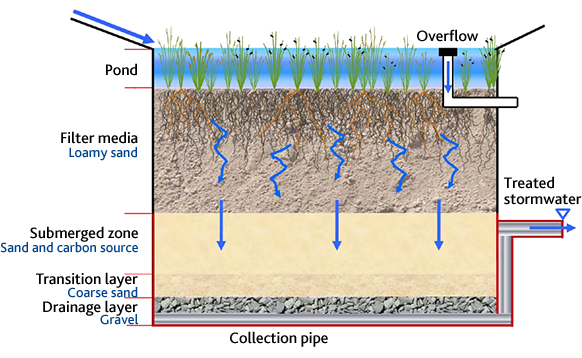Raingardens are specially-designed garden beds that filter stormwater runoff from surrounding areas or stormwater pipes. Raingardens are also called bioretention systems because they use soil, plants and microbes to biologically treat stormwater.
How raingardens work
Although they may look similar to a normal garden, raingardens are designed to stop stormwater run-off from polluting our waterways with nutrients, rubbish and sediment:
-
Water collects and settles on the garden surface
-
Water soaks through the plants and filter media, trapping rubbish and sediment on the surface
-
Plants use the nutrients in the stormwater, and toxins stick to the soil
-
The soil and plant roots work together to naturally filter the water and remove pollutants

Differences to a normal garden
The main differences between a raingarden and normal garden are that raingardens:

- must be cleaned of rubbish and sediment that collects on the surface after it rains
-
should not be fertilised or sprayed with herbicides, as the stormwater should contain enough nutrients
-
have a 200mm to 500mm space above them for water to collect and settle for a few hours
-
use a special soil such as loamy sand, called filter media, that drains quickly and does not release nutrients into the stormwater
Designing a raingarden
Depending on how much water is collected, raingardens range in size from 1 to over 100 square metres, and are usually 1–2% of the catchment area.
They are usually installed after the upstream catchment is 95% developed because poorly managed construction sites create sediment and clog the raingarden. A sediment pond or swale is a good temporary solution to manage sediment during construction.
When designing and building a raingarden, make sure:
- it is designed to treat stormwater runoff from gentle rainfall – runoff from heavy storms should bypass the raingarden into the drainage system
-
the base of the raingarden is above the surrounding groundwater level
-
the filter media is tested before installation to confirm it meets hydraulic conductivity and plant growth standards, and holds adequate moisture to support the plants
Plants
Raingardens need particular plants with roots that help keep the filter media absorbent, and break down the pollution. Only use plants that can grow in sandy soils and tolerate dry conditions for several weeks in between rains.
For further advice on designing raingardens, view the following resources:
Guidelines
Guidelines for raingarden planning, design, construction and maintenance guidelines have been developed by the Cooperative Research Centre for Water Sensitive Cities, with support from Melbourne Water.
Stormwater biofiltration system guidelines - CRC for Water Sensitive Cities
When not to use raingardens
There are areas where raingardens should not be built. These include:
-
flat sites with little difference between the ground surface and waterway water level – raingardens need at least 0.8mm of head between the surface pond and drainage pipe invert
- catchments with high sediment loads, such as industrial areas with disturbed surfaces, or an area where sediment clogging is considered a high risk
-
areas with construction sites upstream
-
areas with constant catchment flows, which may stop the raingarden from drying out to prevent algal growth
Raingardens should also not be built in large catchments with high flows, as these may cause:
-
scouring of the raingarden surface
-
depositing of large sediment loads
-
difficulty in spreading water evenly over a large surface area
Maintenance
Councils can effectively maintain raingardens by splitting responsibility:
-
the Parks and Gardens department maintains garden beds and plants
-
the Roads and Drainage department maintains pits and pipes
Other resources
For detailed information on how to design raingardens, see the design guidance and examples provided in Chapters 5 and 6 'Bio-retention swales & Bio-retention basins' in the WSUD Engineering Procedures available for purchase from CSIRO Publishing.
WSUD Engineering Procedures - CSIRO Publishing